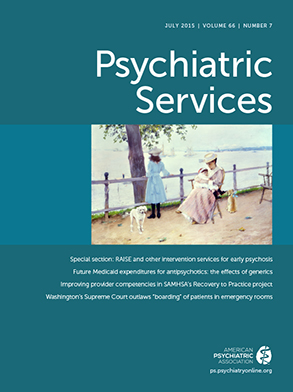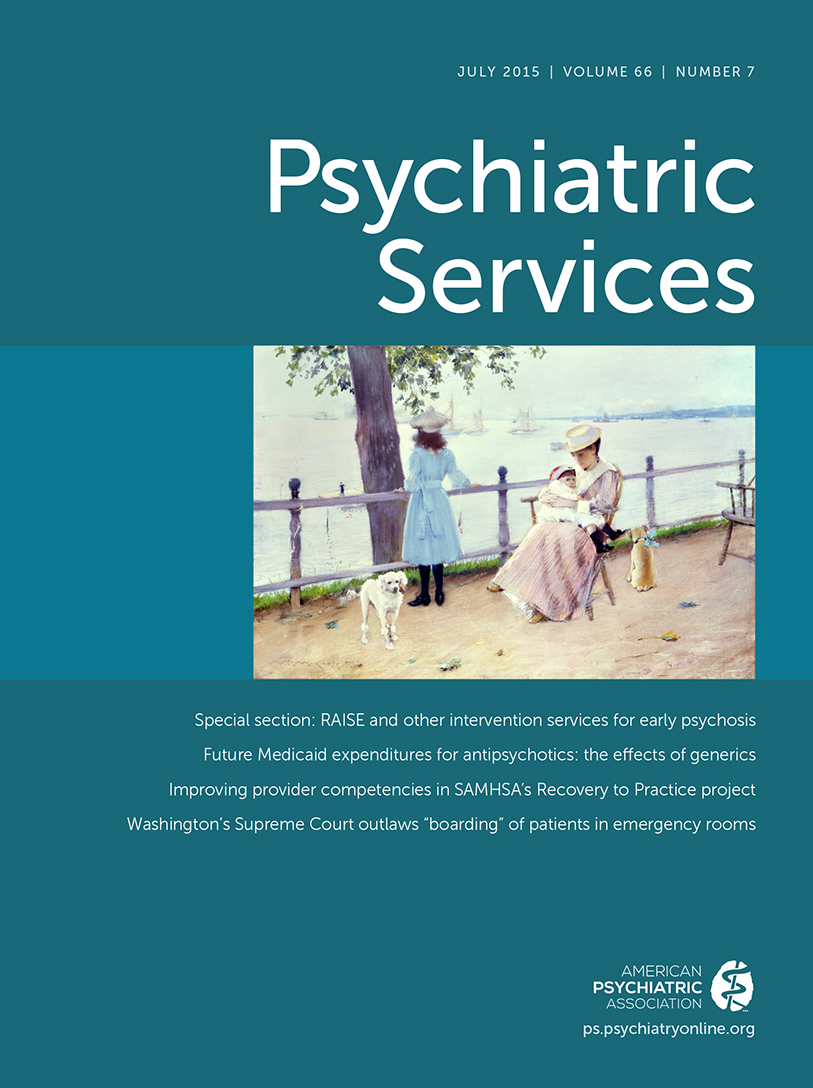Relationship Between General Illness and Mental Health Service Use and Expenditures Among Racially-Ethnically Diverse Adults ≥65 Years
Abstract
Objectives:
Methods:
Results:
Conclusions:
IOM Definition of Disparities and Comorbidities
Methods
Study Population
Dependent Variables
Independent Variables
Statistical Analyses
Results
Health and Sociodemographic Characteristics
| Characteristic | Comorbid illness (N=2,446; %) | No comorbid illness (N=278; %) |
|---|---|---|
| Race-ethnicityb | ||
| White | 57 | 59 |
| African American | 19 | 16 |
| Latino | 23 | 25 |
| Mental health status | ||
| SF-12 mental component score (M±SD)c | 35.8±9.6 | 36.9±9.9 |
| PHQ-2 score (M±SD)d | 4.0±1.2 | 3.8±1.2** |
| Kessler-6 score (M±SD)e | 12.5±4.9 | 11.0±5.2** |
| Self-rated mental healthb | ||
| Excellent | 8 | 10 |
| Very good | 17 | 21 |
| Good | 35 | 33 |
| Fair | 29 | 24 |
| Poor | 12 | 12 |
| Health status | ||
| SF-12 physical component score (M±SD)f | 30.4±10.0 | 38.5±11.8** |
| Self-rated general healthb | ||
| Excellent | 4 | 14** |
| Very good | 12 | 25** |
| Good | 26 | 31 |
| Fair | 34 | 20** |
| Poor | 24 | 11** |
| Any work limitation | 88 | 69** |
| Sex | ||
| Male | 40 | 43 |
| Female | 60 | 57 |
| Age | ||
| 60–74 | 45 | 49 |
| ≥75 | 55 | 51 |
| Marital status | ||
| Married | 48 | 49 |
| Single | 52 | 51 |
| Socioeconomic status (% federal poverty level) | ||
| <100% | 16 | 13 |
| 100%–124% | 11 | 9 |
| 125%–199% | 25 | 24 |
| 200%–399% | 30 | 33 |
| ≥400% | 18 | 21 |
| Educationb | ||
| Less than high school | 41 | 44 |
| High school graduate | 34 | 32 |
| Any college | 14 | 16 |
| College graduate | 12 | 8 |
| Health insuranceg | ||
| Medicaid | 22 | 13** |
| Medicare | 99 | 98 |
| Uninsured | 0 | 2* |
| Regionb | ||
| Northeast | 18 | 15 |
| Midwest | 20 | 19 |
| South | 42 | 41 |
| West | 19 | 26* |
| Urbanicity: in MSAh | 76 | 80 |
Comorbidities and Mental Health Service Use and Expenditures
| Mental health service use (%)b (N=2,724) | Mental health expenditures ($)c (N=969) | |||
|---|---|---|---|---|
| General medical condition | Estimate | SE | Estimate | SE |
| Comorbidity | 40 | 1 | 1,163.02 | 95.10 |
| None | 28 | 4 | 1,101.11 | 397.27 |
| Differenced | 12* | 4 | 61.91 | 409.66 |
Disparities in Mental Health Service Use and Expenditures
| Mental health service use (%)b | Mental health expenditures ($)c | |||||||||||
|---|---|---|---|---|---|---|---|---|---|---|---|---|
| Whites (N=1,563) | African Americans (N=519) | Latinos (N=642) | Whites (N=669) | African Americans (N=107) | Latinos (N=193) | |||||||
| General medical condition | Estimate | SE | Estimate | SE | Estimate | SE | Estimate | SE | Estimate | SE | Estimate | SE |
| Comorbidity | 44 | 2 | 21d | 3 | 34d | 3 | 1,100.98 | 86.81 | 1,179.19 | 281.74 | 1,601.82 | 271.68 |
| None | 34 | 5 | 16d | 7 | 16d | 6 | 859.00 | 144.48 | 3,400.79 | 2,864.48 | 2,266.32 | 1,796.47 |
| Differencee | 10f | 5 | 5 | 8 | 18f | 6 | 241.98 | 168.45 | –2,221.60 | 2,878.30 | –664.50 | 1,816.90 |
Regression Model Results
| Service use (N=2,724) | Expenditures (N=969) | |||
|---|---|---|---|---|
| Variable | Coefficient | SE | Coefficient | SE |
| Race-ethnicity (reference: white) | ||||
| African American | –1.10 | .66 | 1.40 | .85 |
| Latino | –.91 | .50 | .99 | .97 |
| General medical comorbidity | .41 | .24 | .05 | .21 |
| Interaction (reference: whites) | ||||
| African-American comorbidity | –.06 | .70 | –1.40 | .88 |
| Latino comorbidity | .51 | .51 | –.57 | 1.13 |
| Mental health status | ||||
| SF-12 mental componentb | –.04** | .01 | –.01 | .01 |
| PHQ-2 scorec | .05 | .05 | .05 | .08 |
| Kessler-6 score | –.01 | .02 | –.01 | .02 |
| Self-rated mental health (reference: excellent) | ||||
| Very good | .33 | .26 | .13 | .33 |
| Good | .38 | .24 | –.02 | .33 |
| Fair | .86** | .24 | –.02 | .32 |
| Poor | .83** | .26 | .19 | .33 |
| SF-12 physical component | .01 | .01 | –.01 | .01 |
| Self-rated general health (reference: excellent) | ||||
| Very good | –.05 | .36 | .03 | .37 |
| Good | –.02 | .31 | .46 | .31 |
| Fair | .04 | .32 | .32 | .33 |
| Poor | .10 | .32 | .49 | .34 |
| Any work limitation (reference: no work limitation) | .35* | .17 | .16 | .17 |
| Other covariates | ||||
| Female (reference: male) | .47** | .15 | .11 | .17 |
| Age ≥75 (reference: 60–74) | –.55** | .12 | –.06 | .18 |
| Married (reference: not married) | –.09 | .14 | –.23 | .14 |
| % federal poverty level (reference: <100%) | ||||
| 100%–124% | –.09 | .19 | .06 | .33 |
| 125%–199% | .11 | .17 | .07 | .20 |
| 200%–399% | .25 | .18 | –.10 | .22 |
| ≥400% | –.08 | .21 | .22 | .22 |
| Education (reference: less than high school) | ||||
| High school graduate | .02 | .16 | –.05 | .18 |
| Any college | .34 | .19 | .38 | .20 |
| College graduate | .20 | .23 | .76** | .24 |
| Health insurance (reference: private insurance) | ||||
| Medicaid | .02 | .18 | .19 | .21 |
| Medicare | –.11 | .51 | –.70 | 1.30 |
| Uninsured | –.98 | 1.30 | –.66 | 1.31 |
| Region (reference: Northeast) | ||||
| Midwest | .29 | .20 | –.14 | .26 |
| South | .01 | .18 | –.30 | .20 |
| West | .20 | .20 | –.15 | .25 |
| Urbanicity: in MSA (reference: not in MSA)d | .04 | .14 | –.31 | .19 |
| Constant | –.71 | .91 | 7.70** | 1.70 |
Discussion
Conclusions
References
Information & Authors
Information
Published In

Cover: Gravesend Bay, by William Merritt Chase, 1888. Private Collection. Photo credit: Art Resource, New York City.
History
Authors
Funding Information
Metrics & Citations
Metrics
Citations
Export Citations
If you have the appropriate software installed, you can download article citation data to the citation manager of your choice. Simply select your manager software from the list below and click Download.
For more information or tips please see 'Downloading to a citation manager' in the Help menu.
View Options
View options
PDF/EPUB
View PDF/EPUBLogin options
Already a subscriber? Access your subscription through your login credentials or your institution for full access to this article.
Personal login Institutional Login Open Athens loginNot a subscriber?
PsychiatryOnline subscription options offer access to the DSM-5-TR® library, books, journals, CME, and patient resources. This all-in-one virtual library provides psychiatrists and mental health professionals with key resources for diagnosis, treatment, research, and professional development.
Need more help? PsychiatryOnline Customer Service may be reached by emailing [email protected] or by calling 800-368-5777 (in the U.S.) or 703-907-7322 (outside the U.S.).
